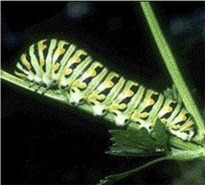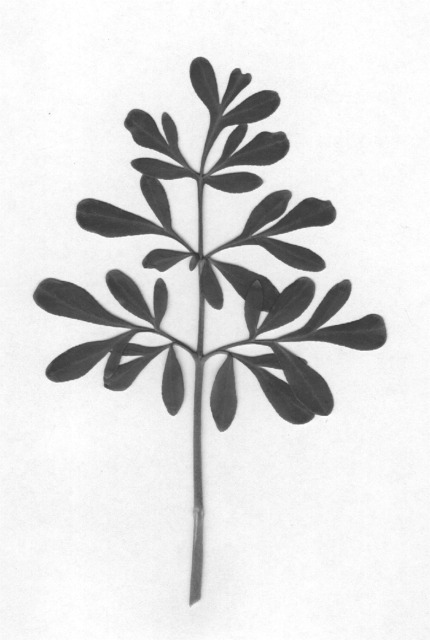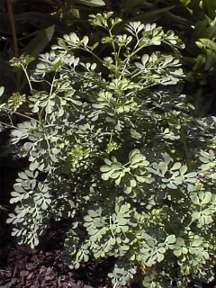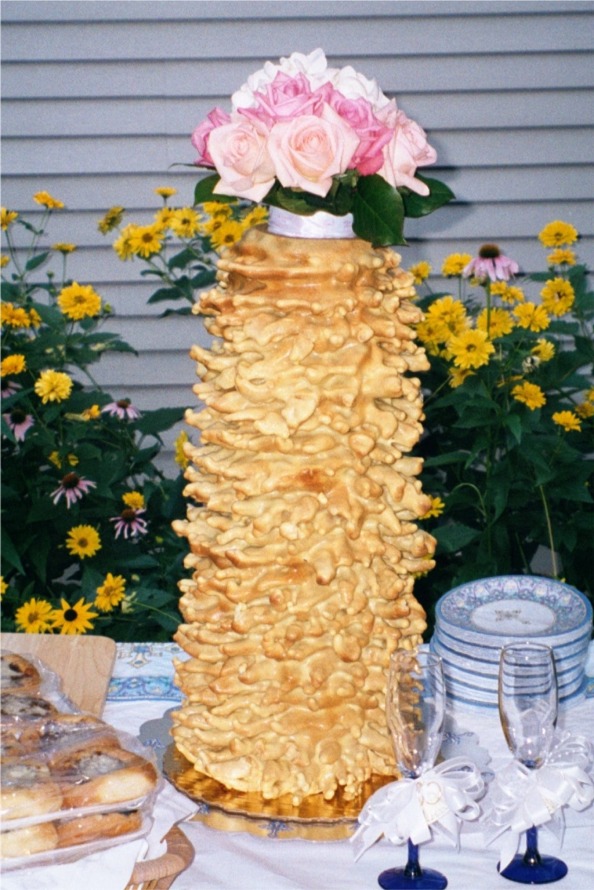The word "ruta" is Latin but comes from the Greek "reuo" which means to set free, referring to the herb's various disease fighting uses. Graveolens is from the Latin words: "gravis" which means heavy, and "olens" for smell, in other words, heavy smelling.
The plant is native to southern Europe and Northern Africa.
As much as I try to create nice flower beds in my parkway, it has been an incredible challenge because it is so exposed to the public. Whenever I planted nice flowers, they would invariably be picked, or torn, or removed. What could I plant that no one would be interested in, yet would grow in poor soil and somewhat harsh conditions? Aha, ruta would work since most people don't even know what it is, it doesn't have showy flowers and it has a strange smell. Besides, ruta thrives in poor soil. So I planted a couple of shrubs.
After some months, when I would come home from work, I starting noticing that sections of the shrub were sort of torn out. This continued for several days. How strange. Was this someone, yet again, just trying to be intentionally destructive? Then one day, I came home and one whole ruta shrub was GONE. All that was left was a hole in the ground. Someone had dug up and stolen the whole damn shrub !!
Well, they weren't going to get the other one, so I quickly dug that one up and moved it into my front yard, inside the fence.
Not much later, I was on vacation from work, so I was home during the day, squatting down while pulling weeds in the front garden. I noticed a small, old Latino lady as she paused in front of my house. She didn't see me. First, for quite awhile, she was looking around at the parkway. Then, something in my front yard caught her attention. She seemed to be looking in the direction of the relocated ruta. I stood up, she was startled by my presence, and seemingly reluctantly went away.
As far as I was concerned, there was my ruta thief.
After describing what happened to some friends, they did not seem surprised. Apparently, in the practice of Santeria, ruta is a common ingredient in spells and potions.And, the potion is even stronger if the ruta is stolen. There aren't too many rutas growing in my neighborhood, so my shrubs must have been a good source of stolen ruta for that little Latino lady. Well, that's my theory, anyway.
Besides dill and parsely, ruta is a favorite food of the caterpillar of the Black Swallowtail Butterfly. While working in my garden, I have witnessed the butterfly laying her eggs on the ruta shrub.
As a child, I would often find these pretty caterpillars on our rutas in front of the house, chomping away at the leaves. One time, I put one in a jar and kept it supplied with ruta leaves. Ultimately, it transformed into a pupa and finally the beautiful butterfly emerged.
For some reason, this relationship between ruta and butterfly is very pleasing to me.
There haven't been any Black Swallowtail Butterflies in my yard for several years now. I keep hoping they will return.
Papilio polyxenes

(Photo by Paul A. Opler)
Ruta has been used since ancient times, mainly for medicinal and antimagical purposes.
- Aristotle said it eased the nervous indigestion suffered when eating in the presence of foreigners. The Greeks attributed this reaction to witchcraft on the part of the guests, so ruta was considered an antimagical herb.
- The Roman naturalist and writer, Pliny, claimed that carvers, painters and engravers ate ruta in great quantities to improve their eyesight after the vision became dim from over-exertion. These included Michelangelo and Leonardo da Vinci.
- Gunflints that were boiled in a mixture of ruta and vervain were said to improve the shooter's aim.
- King Mithradates of Asia Minor ate ruta to prevent being poisoned by enemies, taking the herb gradually in increasing doses. He then attempted suicide by, get this, poisoning and failed. He had to persuade a slave to stab him.
- During the Great Plague of 1665, a band of thieves fortified themselves with a herbal vinegar which included ruta. They believed this would protect them from plague and so, made a living stealing from the corpses.
- During the sixteenth and seventeenth centuries, ruta was scattered all around courtrooms and judges carried branches of it to ward off "jail fever." These bouquets are still presented to British judges today, in a continuing tradition.
- Shakespeare dubbed ruta the "Herb of Grace."
- As a symbol of repentance, brushes of ruta were used to sprinkle holy water before a Roman Catholic high mass.
- Thomas Jefferson indicated that ruta was a "must have" in his gardens at Monticello.
- Ruta was the early model for the suit of clubs used in playing cards.
I don't recall the Lithuanians every using ruta in cooking, only for medicinal purposes. However, though used more prior to this century, ruta is still used as a "spice" today. It is said to be quite bitter, similar to the taste of bitter blue cheese.
Apart from occasional use in Italy, ruta's popularity is greatest in Ethiopia, where ruta is sometimes named as a components in the national spice mix, berbere. Ethiopian cuisine is unique in using not only ruta leaves, but also the dried fruits (ruta berries) with their more intensive, slightly pungent flavour. Ruta seeds are an ingredient in the Ethiopian Jewish dish called Shiro Wat.

Like many other bitter spices, ruta is popular for flavouring liquors.
One of the most common liquors containing ruta is grappa con ruta, an
Italian brandy flavoured with a small branch of ruta per bottle.
It is listed as an ingredient in two ancient Roman dishes, SARDA
ITA FIT (Tuna) and ALITER DULCIA, a kind of dessert.
One can cook using the ruta flavor without the bitterness; the ruta leaves excrete the essential oil much more quickly than the bitter rutin (very similar to tea leaves). So, the fresh leaves may be soaked in a slightly boiling sauce for a short time (typically, one minute) and discarded afterwards. A maximum of flavor at a minimum of bitterness is achieved.
My mother used to tell me how people in the village where they lived in Lithuania would come to my grandmother and she would make up some concoction of ruta tea for them. I recall it had to do with some kind of digestive and urinary problems.
You can find an enormous amount of information on the web about the medicinal uses of ruta. It is also one of the prominent remedies used in homeopathy. Modern research continues to discover new uses for this herb.
It seems to cover three primary areas: menstrual problems, digestive problems, and, used externally, in the treatment of rheumatism type of complaints.
If taken in large doses, it is considered highly toxic. Pregnant women are warned to stay away from ruta as it can cause spontaneous abortion; and because of it's antimicrobial properties, it has been said to cause sterility in men. Maybe that's why it was used as a form of birth control in Lithuania.
Additionally, some people are highly allergic to the volatile oils in the leaves and can develop a poison ivy type rash if they brush against the leaves. Similar to St. John's wort, overexposure to sunlight after ingesting ruta can result in severe sunburn. In my experience, if I scratch my skin slightly, let's say on the thorns of my roses, and then brush that skin against the ruta leaves, my scratches will turn a brownish color which won't go away for several months ! (Hmm, perhaps an ingredient in a long lasting self-tanner?)
Ruta is easy to grow in my climate. It dies all the way back in winter,
and it needs to be cut back to old wood in early spring. It's been my
experience that some plants seem to live forever, and others will last
only a few years. That is why I let several volunteer plants get started
from seed every year, so that I always have a supply of plants.
It does like full sun.
I had heard that it is good to plant ruta near roses as it well prevent pests and disease, but I have not found that to be true. Apparently, ruta and mint should not be planted together - the mint will fare better. I've never tested this.
I had also heard that dogs and cats don't like the smell and will stay away from it. I have first hand experience that this is NOT true:
- One of the other reasons I had planted ruta on my parkway is to keep the peeing dogs off. Didn't work.
- I was having a problem with stray cats using my garden as their litter box. One day I saw the cat brushing up against the ruta. So much for that.
I found a web site in India that claims that snakes do not like the smell and therefore will be repelled. I don't have snakes in my yard, so I cannot confirm or deny this.
The roots of ruta yield a red dye.
They say that ruta stolen from a neighbor's garden grows best. What's with this stealing of ruta?
From all the reading I have done, there is great disagreement about the smell of ruta - some say it is highly disagreeable, others consider it aromatic. There is no denying that it is strong and unusual. I grew up with the smell, and therefore, it is very familiar and a part of my memories. I will often rub the slightly fleshy leaves to release the oils and then give it a good strong whiff.
Ruta plays a very big part in the Lithuanian culture, as well as in many other cultures of the region (Latvian, Polish, etc.). Growing up in Chicago, we always recognized a Lithuanian household if there was a ruta planted in front of it.
When a Lithuanian girl gets married, she wears a wreath of ruta on her head After the ceremony, the wreath is removed by the bridesmaids and replaced with a white wimple. The removal of the wreath signifies the end of her girlhood, and the wrapping of the wimple indicates her new status as a matron. A bunch of ruta was often used to decorate the top of the tradional Lithuanian wedding cake, called either raguolis (horn cake) or sakotis (branch cake).
A stylized image of the ruta leaves is used in all kinds of Lithuanian folk art: wood carvings, weavings, etc. My aunt, Sesele Terezina, who was a nun in a Lithuanian order of Catholic nuns, would make her own stationery by laying down a ruta sprig on the paper and then spraying some kind of paint over it. Fortunately, I saved one of her birthday greetings to me that I received from her as a child.
And then there are Lithuanian folk songs, which are chock full of reference to ruta. Here is one that I remember from childhood, along with my own translation to english:
| pharm | Herba Rutae | |
| Amharic | Taena Adam | |
| Bengali | Ermul | |
| Chinese |
Chow-cho |
|
| Danish | Rude | |
| Dutch | Wijnruit | |
| English | Rue, Herb of Grace | |
| Estonian | Ruud, Aedruud | |
| Finnish | Ruuta, Tuoksuruuta | |
| French | Rue odorante, Herbe de grace | |
| German | Raute, Weinraute, Gartenraute | |
| Gujrati | Satapa | |
| Hindi | Satari | |
| Hungarian | Ruta, Kerti ruta | |
| Icelandic | Ruturunni | |
| Italian | Ruta | |
| Kannada | Sadabu | |
| Lithuanian | Ruta | |
| Malay | Daun aroda | |
| Marathi | Satapa | |
| Norwegian | Vinrute | |
| Oriya | Maruya | |
| Polish | Ruta zwyczajna | |
| Portuguese | Arruda | |
| Sanskrit | Sadapaha | |
| Singhalese | Aruda | |
| Spanish | Ruda | |
| Swedish | Vinruta | |
| Tamil | Arvada | |
| Telugu | Aruda, Sadapa | |
| Turkish | Sedef Otu | |
| Urdu | Sudah | |
So, the English translation of my name is NOT Ruth !!
If you know any other interesting information or traditions regarding ruta, please post it in the Guest Book so I can share with everyone else. THANKS !


